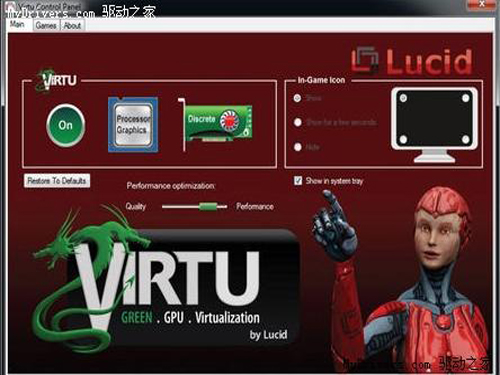 Because the Intel Sandy Bridge micro-architecture processor integrates graphics cores from low-end to high-end, it is increasingly important for the desktop platform to display/set the automatic switching technology. Currently, the Virtu technology from Israel's LucidLogix is ​​the only announced automatic switching scheme for desktop graphics. However, the SemiAccurate website received news that NVIDIA and AMD also have their own similar programs under development.
Because the Intel Sandy Bridge micro-architecture processor integrates graphics cores from low-end to high-end, it is increasingly important for the desktop platform to display/set the automatic switching technology. Currently, the Virtu technology from Israel's LucidLogix is ​​the only announced automatic switching scheme for desktop graphics. However, the SemiAccurate website received news that NVIDIA and AMD also have their own similar programs under development. LucidLogix's Virtu technology allows the Sandy Bridge platform to turn off discrete graphics when it is used for office and network applications, and automatically launches discrete graphics when applications such as games and video hardware acceleration are enabled. More importantly, the QuickSync video transcoding capabilities of the Intel Sandy Bridge processor integrated graphics core have proven to be extremely fast, and Virtu is currently the only solution that can continue to use QuickSync technology on the standalone platform.
However, Virtu also has its fatal problem, that is, price. LocidLogix achieved profitability by charging Virtu technology licensing fees from motherboard manufacturers. The price is said to be as high as $10 per motherboard, and high-volume orders can be reduced to around $5. At present, only Intel Corporation, one of the investors of LucidLogix, has announced that it will bundle Virtu software in some of the future original H67 and P67 motherboards.
Allegedly, the major Taiwanese motherboard manufacturers occupying the market's leading position did not immediately defect to the Virtu program. In addition to price considerations, what is more important is that they have learned from AMD and NVIDIA that the two manufacturers will be in the next few months. Each will launch their own desktop independent display / set display automatic switching program, and is completely free. Compared to Virtu, these Solutions may have some advantages, such as at least the problem that the discrete graphics driver setting interface cannot be used.
Since NVIDIA already offers Optimus automatic switching technology on mobile platforms, similar desktop solution development should be simpler and may continue to use the Optimus brand. On the other hand, AMD said that its switching plan may not be solely for Sandy Bridge, but is closely related to their APU plan.
These products are used in intelligent high-frequency switching power supply, electric power supply, railway power supply, large LED power supply, and uninterruptible power supply(UPS)
power connector
Huizhou Fibercan Industrial Co.Ltd , https://www.fibercaniot.com
